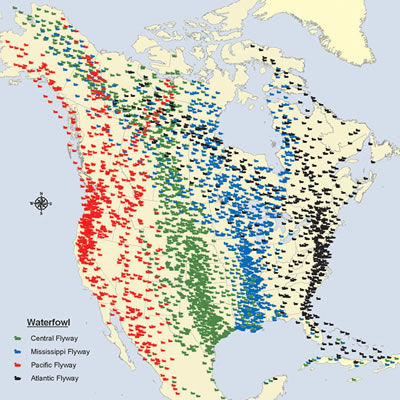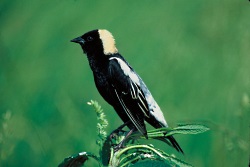
Courtesy US FWS
Hi I’m Holly Strand.
Every fall, I scan the sky for the fluid lines of birds heading south to their winter homes. Although the flocks are fascinating to watch, I get a bit melancholy. I imagine the warm and balmy weather ahead of them and the frigid temperatures that are in store for me.
Migration behavior in birds –and other animals– evolved to help them cope with a scarcity of resources during a particular time of the year. Severe weather and lack of food are characteristic of winters in the far north of the Northern Hemisphere. Therefore almost all of the birds migrate. Although more hospitable than the arctic, Utah winters are no picnic. Therefore, birds that breed in Utah have also bought heavily into migration.

gather at the Great Salt Lake
before migration.(female)
Photo courtesy and
Copyright © 2008 Stephen Peterson
Looking at a map of Western Hemisphere migration routes –or flyways—you might be reminded of the route map of a major airline. There are short regional flights, say to an adjacent state to the south or sometimes just to a lower altitude. There are medium distance flights to Mexico or Central America. And then there are the long haul flights, with birds flying from northern tundra all the way to Argentina, Chile or Antarctica.
Wilson’s phalarope is one of Utah’s long-distance migrators. After the breeding season, about 500,000 birds form the largest staging concentration of phalaropes in the world at the Great Salt Lake. After fueling up on brine shrimp and brine flies, the birds head off to wetlands in Bolivia and Argentina.

gather at the Great Salt Lake
before migration.(male)
Photo courtesy and
Copyright © 2008 Stephen Peterson
Swainson’s hawk travels farther than any other North American hawk. It migrates to the Argentinian pampas in huge flocks with as many as 5,000–10,000 individual. If a Swainson’s hawk begins migration in the northern part of its range, total round trip distance will exceed 20,000 km.
The rufous hummingbird doesn’t breed in Utah but flies though on its remarkable journey from the northwest and Alaska to Central America. If you measure its travel in body lengths as opposed to distance, this tiny little aviator makes world’s longest known migration.
For pictures and sources please go to www.wildaboututah.org
Thanks to the knowledgeable folks on the UtahBirds chatline for their help in developing this story.

in Starr, UT will overwinter
in Argentina.
Photo courtesy and
Copyright © 2006 Lu Giddings
For Wild About Utah, I’m Holly Strand
Credits:
Photo: Courtesy US FWS National Digital Library
Swainson’s Hawk: Courtesy and Copyright 2006 Lu Giddings
Text: Holly Strand
Sources & Additional Reading
Bechard, Marc J., C. Stuart Houston, Jose H. Sarasola and A. Sidney England. 2010. Swainson’s Hawk (Buteo swainsoni), The Birds of North America Online (A. Poole, Ed.). Ithaca: Cornell Lab of Ornithology; Retrieved from the Birds of North America Online: https://bna.birds.cornell.edu/bna/species/265

the rufous hummingbird
has the longest migration
in the world in relation to its size.
Photo courtesy and
Copyright © 2010 Michael Fish
Berthold, Peter. 2001. Bird Migration: A General Survey (second edition). Oxford Ornithology Series. Oxford University Press. https://www.amazon.com/Bird-Migration-General-Survey-Ornithology/dp/0198507879
Colwell, M. A. and J. R. Jehl, Jr. 1994. Wilson’s Phalarope (Phalaropus tricolor), The Birds of North America Online (A. Poole, Ed.). Ithaca: Cornell Lab of Ornithology; Retrieved from the Birds of North America Online: https://bna.birds.cornell.edu/bna/species/083
Elphick, Jonathan, Ed. The Atlas of Bird Migration. 1995. NY: Random House. https://www.amazon.com/Random-House-Atlas-Bird-Migration/dp/0679438270
Healy, Susan and William A. Calder. 2006. Rufous Hummingbird (Selasphorus rufus), The Birds of North America Online (A. Poole, Ed.). Ithaca: Cornell Lab of Ornithology; Retrieved from the Birds of North America Online: https://bna.birds.cornell.edu/bna/species/053

collects nesting material
Photo courtesy US FWS
George Gentry, Photographer
USGS. Northern Prairie Wildlife Research Center Migration of Birds. https://www.npwrc.usgs.gov/resource/birds/migratio
/routes.htm [ Accessed October 28, 2010]
Weidensaul, Scott 1999. Living on the Wind. NY: North Point Press https://www.amazon.com/Living-Wind-Across-Hemisphere-Migratory/dp/0865475911
Salt Lake Brine Shrimp, https://saltlakebrineshrimp.com/harvest/

